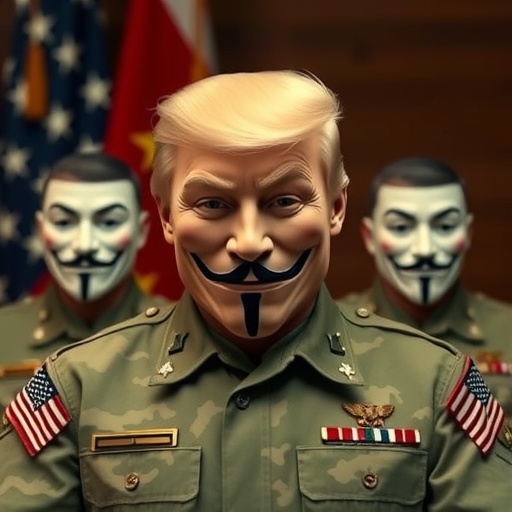Anonymous Trump Ally Donates $130 Million to Secure Military Pay During Government Shutdown Crisis
In a stunning act of philanthropy amid escalating political turmoil, an anonymous donor believed to be a close ally of former President Donald Trump has pledged $130 million to ensure U.S. military personnel receive their paychecks during the ongoing government shutdown. This Anonymous donation comes at a critical juncture, as hundreds of thousands of federal workers, including active-duty troops, face the prospect of missed pay amid the impasse in Washington.
The government shutdown, now in its third week, stems from heated debates over border security funding and has left approximately 800,000 federal employees without pay. For the roughly 2.1 million active-duty service members, the uncertainty has been particularly acute, with families bracing for financial hardship. The donor’s intervention, funneled through a trusted intermediary to the Pentagon, aims to bridge this gap and provide immediate relief for military pay.
Details of the donation emerged late Friday evening from sources close to the Pentagon, highlighting the urgency as holiday bills pile up and morale wanes among the ranks. “This gesture underscores a profound commitment to our nation’s defenders,” a Pentagon spokesperson said in a brief statement, declining to speculate on the donor’s identity but confirming the funds would be allocated swiftly to cover December paychecks.
Shutdown Strains Military Families as Paychecks Stall
The government shutdown has cast a long shadow over military bases across the country, where service members continue their duties without the financial security of a paycheck. According to the Department of Defense, active-duty personnel are legally entitled to back pay once funding resumes, but the immediate cash flow disruption has led to widespread anxiety. In a survey conducted by Military Family Advisory Network last week, 45% of respondents reported dipping into savings or seeking emergency loans to cover essentials like rent, groceries, and childcare.
Take the case of Sergeant Maria Gonzalez, a single mother stationed at Fort Bragg, North Carolina. “We’ve been budgeting tightly, but with Christmas around the corner and my kids expecting gifts, this shutdown feels like a punch to the gut,” Gonzalez shared in an interview with reporters outside the base. Her story echoes thousands: from E-1 privates earning around $1,800 monthly to senior officers pulling in over $10,000. The military pay halt affects not just troops but also 700,000 civilian Pentagon employees, many of whom support defense operations.
Economically, the ripple effects are stark. The American Action Forum estimates that each week of the shutdown costs the U.S. economy $1.5 billion in lost productivity, with military communities hit hardest. In areas like San Diego, home to Naval Base Coronado, local businesses report a 20% drop in sales from furloughed workers and anxious families. Food banks near bases, such as those operated by the USO, have seen a 30% uptick in demand, underscoring the human cost behind the partisan deadlock.
Historically, shutdowns have tested military resilience. During the 2018-2019 impasse—the longest in U.S. history at 35 days—over 200,000 service members went unpaid, leading to a spike in financial counseling requests at installations worldwide. This time, with midterm election fallout fueling the debate, experts warn of prolonged uncertainty unless Congress acts swiftly.
Unmasking the Enigmatic Trump Ally Behind the Donation
Speculation is rife about the identity of the Trump ally orchestrating this Anonymous donation. While the donor remains shrouded in secrecy, clues point to a network of high-profile supporters from Trump’s inner circle, known for their unwavering loyalty and deep pockets. Sources familiar with the transaction suggest the funds originated from a private foundation linked to real estate magnates and conservative philanthropists who backed Trump’s 2016 and 2020 campaigns.
One name surfacing in whispers is that of Miriam Adelson, the billionaire widow of casino mogul Sheldon Adelson, a prolific Trump donor who contributed over $200 million to Republican causes. Though unconfirmed, her history of anonymous giving aligns with the profile—last year, she funneled $100 million into pro-Israel initiatives without fanfare. Alternatively, whispers in GOP circles point to figures like Geoffrey Palmer, a Los Angeles real estate tycoon who hosted Trump fundraisers, or even tech entrepreneur Peter Thiel, whose libertarian leanings and military tech investments make him a plausible candidate.
The donor’s choice to remain anonymous adds intrigue, possibly to avoid political backlash or maintain focus on the cause. “In times of crisis, true patriots step up without seeking credit,” remarked a former Trump administration official, speaking on condition of anonymity. This Anonymous donation mirrors past gestures, such as the 2019 crowdfunding effort that raised $20 million for border wall construction, largely driven by Trump supporters.
Legal experts note that such donations to federal entities must navigate strict ethics rules. The Pentagon has assured compliance, with the funds designated as a restricted grant for military pay supplementation. However, questions linger: Will this inspire copycat philanthropy, or expose rifts in how private wealth intersects with public service?
Tracing the Funds: From Donor to Defense Department
The logistics of the transfer reveal meticulous planning. The $130 million was wired through a neutral third-party nonprofit, the National Defense Fund, which specializes in emergency military support. This entity, audited annually by the IRS, ensures transparency while preserving donor anonymity. Pentagon comptrollers are now integrating the sum into payroll systems, prioritizing enlisted personnel and those with dependents.
Breakdown of the allocation provides clarity: Approximately $100 million targets active-duty military pay, covering base salaries for 1.3 million troops at an average of $4,000 per pay period. The remainder bolsters support for National Guard and Reserve members, who number 800,000 and often juggle civilian jobs. “This isn’t a handout; it’s a lifeline,” said retired General Mark Milley in a CNN op-ed, emphasizing the donation’s role in sustaining readiness.
Pentagon Scrambles to Distribute Funds Amid Operational Challenges
The Pentagon has moved with urgency to operationalize the anonymous donation, establishing a dedicated task force to oversee distribution. Defense Secretary Lloyd Austin issued a memo Friday directing immediate payroll processing, with direct deposits expected by mid-week. “Our service members’ sacrifices demand unwavering support, especially in uncertain times,” Austin stated, praising the donor’s foresight.
Internally, challenges abound. The shutdown has furloughed 40% of civilian staff, forcing uniformed personnel to handle administrative burdens. At the Defense Finance and Accounting Service in Indianapolis, a hub for military pay processing, overtime shifts are the norm. Statistics from the Government Accountability Office indicate that past shutdowns delayed payments by up to two weeks, exacerbating stress and turnover—rates among junior enlisted rose 15% post-2019.
Quotes from the front lines paint a vivid picture. Airman First Class Jamal Reed, deployed to Ramstein Air Base in Germany, told Fox News, “Knowing help is coming lifts a weight off. We’ve got missions to fly, not bills to chase.” Similarly, Marine Corps families in Camp Pendleton have organized community potlucks to foster solidarity, a grassroots response amplified by the donation’s promise.
Beyond pay, the infusion addresses ancillary needs. The Pentagon plans to allocate 10% of funds—$13 million—for morale programs, including holiday meal vouchers and family counseling. This holistic approach counters the shutdown’s psychological toll, where studies from the RAND Corporation show a 25% increase in anxiety disorders among affected personnel.
- Key Distribution Milestones: Initial assessments by December 15; full payouts by December 20; audits completed by January 5.
- Beneficiary Breakdown: 60% Army/Navy, 25% Air Force/Space Force, 15% Marines/Coast Guard.
- Oversight Measures: Independent review by the DoD Inspector General to prevent misuse.
Ripples of Relief: How the Donation Reshapes Shutdown Narratives
As news of the anonymous donation spreads, it has injected a rare note of bipartisanship into the government shutdown discourse. Congressional leaders from both sides expressed gratitude, with House Speaker Mike Johnson calling it “a beacon of American generosity.” Senate Minority Leader Chuck Schumer echoed, “Whatever the source, it reminds us of our shared duty to those who serve.”
Yet, the gesture underscores deeper fissures. Critics argue it highlights government dysfunction, where private citizens must fill voids left by elected officials. The Trump ally‘s involvement has sparked partisan commentary: Trump himself posted on Truth Social, “Great to see real leaders stepping up—Democrats take note!” This politicization risks overshadowing the aid’s intent, even as polls from Gallup show 70% public approval for the donation.
Economists project broader impacts. By stabilizing military pay, the infusion could prevent a $5 billion hit to consumer spending in defense-heavy regions like Virginia and Texas. Local chambers of commerce report early signs of rebound, with retailers near bases anticipating holiday upticks. Moreover, it may pressure negotiators: Sources indicate the White House is fast-tracking talks, aiming for resolution before New Year’s.
Lessons from Past Shutdowns: Avoiding Repeat History
Reflecting on precedents, the 1995-1996 shutdowns affected 800,000 workers and cost $1.4 billion, per CBO estimates. The 2013 event furloughed 850,000, including Smithsonian staff, but spared most military pay through contingency funds. This latest crisis, triggered by disputes over $14 billion in border aid, differs in scale, with potential duration exceeding 30 days absent compromise.
Advocacy groups like the National Military Family Association are pushing for legislative fixes, such as the proposed Military PAY Act, which would guarantee on-time pay during lapses. The anonymous donation buys time but amplifies calls for reform.
Looking Ahead: Sustaining Support as Negotiations Intensify
With the Pentagon poised to execute payouts, attention shifts to sustaining momentum. The donor’s $130 million covers immediate needs but won’t resolve underlying issues if the government shutdown drags on. Experts forecast that extended delays could strain recruitment, with the military already missing goals by 25% in 2023 due to quality-of-life concerns.
Forward momentum includes bipartisan briefings scheduled for next week, where lawmakers will review the donation’s efficacy. Philanthropic circles buzz with potential follow-ups; the Giving Pledge network, comprising billionaires committed to charity, may rally additional support. For troops, this means not just financial relief but renewed focus on core missions—from countering threats in the Indo-Pacific to domestic disaster response.
In the end, this Trump ally‘s bold move reframes the narrative from gridlock to gratitude, urging Washington to prioritize those who stand guard. As one veteran put it, “Paychecks are vital, but so is the promise that America has our backs.” The path forward hinges on dialogue, but for now, the ranks breathe easier knowing help has arrived.










